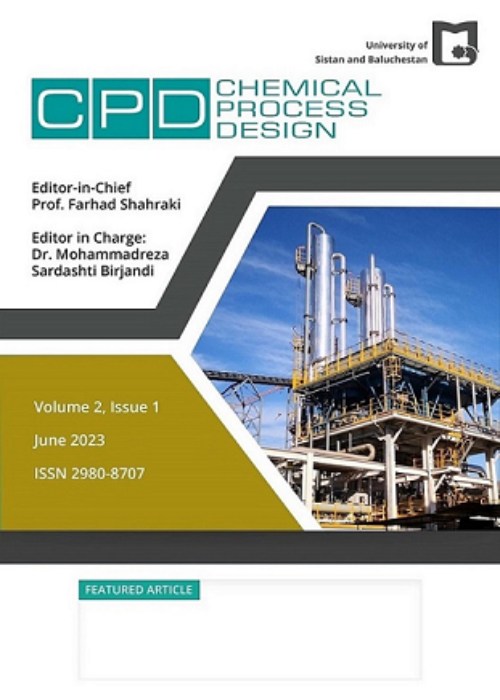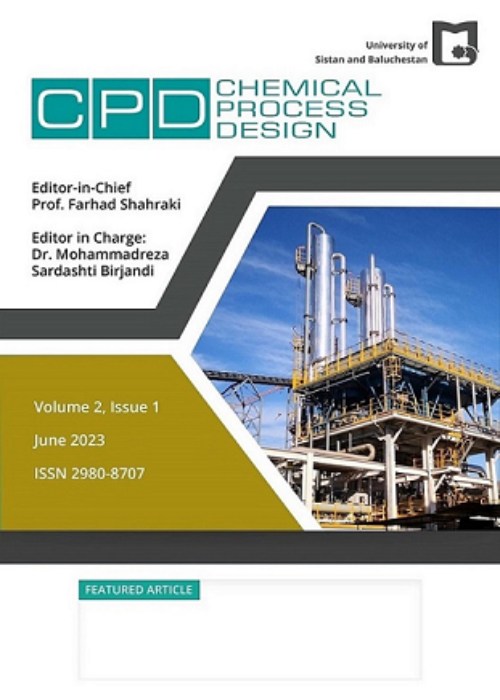فهرست مطالب

Chemical Process Design
Volume:2 Issue: 1, Jun 2023
- تاریخ انتشار: 1402/04/02
- تعداد عناوین: 6
-
Pages 1-5In this study, the concentration of total petroleum hydrocarbon (TPH) remaining in the sediments of Asaluyeh (a city in Fars province) that were polluted in the fall of 2021 due to gas condensate leakage was investigated. After the accident, soil from deeper layers was mixed with surface soil and rain washed some of the pollution deeper into the soil. Five months after these operations, the TPH level of the soil was measured. The results showed that the concentration of soil pollution in the study area was 356.5 µg/g, which corresponds to the lower end of the moderate pollution range.Keywords: Oil accidents, Oil spills, Gas condensate, Total petroleum compounds (TPH)
-
Pages 6-30The growth of hydrocarbon resources dramatically influences the energy market's future. Digital Rock Physics (DRP) is a scientifically accepted approach for evaluating reservoirs' rock qualities. In theory, knowing the geographical distribution of the linked pore space enables one to anticipate the characteristics of a rock sample. But upscaling predictions systematically hasn't been possible yet due to restrictions on unique microscopic resolution and approximated measurements. Getting information about the structure through tomographic pictures of porous materials is an essential part of porous media investigation. The ability to extract pore networks is especially beneficial because it allows for pore network modeling simulation studies, which can also be helpful for various tasks ranging from modeling transportation characteristics to predicting the effectiveness of the whole equipment. This paper deals with a comprehensive overview of the importance, steps and methods of simulating the porous medium using pore network modeling and all their necessary prerequisites. For this purpose, instead of using continuum-based modeling it has been tried to enter in the pore scale and review the steps of modeling that happen in that according to image-based methods mentioned by previous researchers, which are very useful for modeling complex geological materials.Keywords: Pore Network Modeling, Digital Rock Physics, Porous media, Reconstruction Algorithms, Open PNM
-
Pages 31-41Volatile Organic Compounds (VOCs) are a large group of chemicals that are found in many products. The VOCs emission has become a serious challenge due to their adverse effects on human health and the ecological environment. Consequently, the development of various technologies to eliminate VOCs is an undeniable necessity. To develop an effective elimination technique, computational modeling is a powerful tool for process assessment. In this study, computational modeling was conducted to analyze the transport phenomena during the photocatalytic degradation of toluene, in a supported ionic liquid membrane reactor. The mass transfer coefficient and reaction rate constant were estimated and the flux magnitude and flux streamlines were also determined and analyzed. Furthermore, the membrane permeance was also determined as a function of membrane channel length and time. The accuracy of the model was confirmed by fitting the actual average concentration of the toluene and the values predicted by the model over time.Keywords: Membrane reactor, Modeling, Volatile organic carbon, Photocatalyst
-
Pages 42-57
Hydrogen is the key to achieving sustainable and clean energy in the world's future, and research in the field of optimal hydrogen production has been growing in the past years. This research discusses the mathematical modeling of the Methanol Steam Reforming Process in membrane reactors to produce hydrogen. Modeling is developed with the principles of energy, mass, and momentum conservation; In cases where the temperature is constant, only the conservation of mass will be used, and both energy and mass equations will be used in non-isothermal cases. This modeling is finally upgraded from one-dimensional to two-dimensional in the length and radial of the reactor. In each mathematical model, molecular and thermal diffusion relations are used as auxiliary equations to complete the modeling. In the final step, the effect of different variables such as temperature, pressure, and the reactor and membrane's physical conditions is analyzed to determine the optimal operating conditions for the developed mathematical models. The predictability of chemical processes behavior like the methanol steam reforming process can be achieved through basic mathematical modeling concepts. The results from the conceptual examination of the mathematical model are compared with various simulation results carried out in other articles, revealing their consistency. Basic mathematical models are superior to complex simulations as they can be leveraged to develop intelligent expert systems or predictive maintenance programs that deliver desired outcomes rapidly and cost-effectively.
Keywords: Methanol steam reforming, mathematical modeling, Hydrogen production, Membrane reactors, Conservation of mass, energy, System analysis -
Pages 58-70
The intentional agreements against the climate change recommend the countries to utilize natural gas instead of other fossil fuels in order to reduce carbon emission and this is a good opportunity for the countries with large resources of natural gas to develop the industries in relation to natural gas products. Regarding the existence of the largest gas field in the vicinity of the Iran’s South Pars Zone (SPZ), large gas refineries and ethane-based petrochemical complexes have been established in this region. In this paper, the appropriate strategies comprised of optimizing the energy consumption, recycling of waste plastics to manufacture second grade plastic by the aid of petrochemical facilities, conversion of the fuel system in the vehicles and investment on the renewable energies were investigated. Regarding the high demand for natural gas in the world, development of the industries, related to natural gas such as construction of LNG (liquefied natural gas) plants can increase the incomes by export and also aid the other countries to contribute in the carbon reduction plans.
Keywords: climate change, Carbon emission, Natural gas, South Pars Zone, renewable energy -
Pages 71-80Despite distillation's popularity in the industry, it is highly energy-intensive. Heat integration is, therefore essential considering the recent energy crisis. This paper presents thermal coupling as an approach for separating the ternary mixture of n-pentane, n-hexane, and n-heptane. In this method, the first column supplies vapor to the second column while its reboiler is removed. The thermal coupling method is evaluated using two classical arrangements, direct and indirect with and without heat integration. Simulation of separation processes is carried out using Aspen HYSYS, and distillation columns are simulated using the rigorous solving method rather than the shortcut method. The simulation results are compared to those obtained using the shortcut method (minimum produced steam). Furthermore, exergy analysis is used for assessing processes in addition to energy analysis. It has been demonstrated that direct sequence provides better results than indirect sequence. Moreover, direct-thermal coupling is considered the most efficient process among the four investigated processes. It has been concluded that compared to the indirect process without heat integration, the direct-thermal coupling sequence can reduce energy consumption and exergy loss by 69% and 55%, respectively, as well as improve exergy efficiency by 9%.Keywords: heat integration, direct, indirect, thermal coupling, exergy


